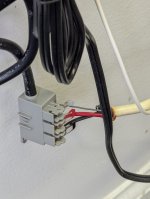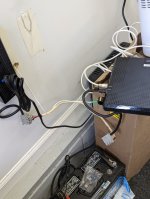So I was upgraded to FIOS Gigabit. Or close to a gigabit.
Connection to router must be network cable, no more coax. It was coax until today. House is wired for coax.
So ONT is on outside of garage and router is on the inside. Network cable as of this morning runs through a window cracked open. Router next to the window. Power to the ONT is via a cable through a hole in the the wall.
I absolutely hate drilling holes through my house so that will not happen. Or boat or car.
Options:
1) call Verizon and have them relocate the ONT inside. They do not like people messing with the ONT. Pay $$.
2) Run CAT6 through same hole as power cable for ONT. I would have to buy a second crimper as my good one is at church camp 6 hours away
Cannot get pre-terminated network cable through the wall.
3) Run the main outdoor fiber to the inside of my garage through the hole the power cable use to go through. Relocate the ONT inside.
4) There is already a short fiber extension between the ONT and outdoor fiber. Get a longer one and run that extension through the hole the power cable use to go through. Relocate the ONT inside.
Connection to router must be network cable, no more coax. It was coax until today. House is wired for coax.
So ONT is on outside of garage and router is on the inside. Network cable as of this morning runs through a window cracked open. Router next to the window. Power to the ONT is via a cable through a hole in the the wall.
I absolutely hate drilling holes through my house so that will not happen. Or boat or car.
Options:
1) call Verizon and have them relocate the ONT inside. They do not like people messing with the ONT. Pay $$.
2) Run CAT6 through same hole as power cable for ONT. I would have to buy a second crimper as my good one is at church camp 6 hours away
Cannot get pre-terminated network cable through the wall.
3) Run the main outdoor fiber to the inside of my garage through the hole the power cable use to go through. Relocate the ONT inside.
4) There is already a short fiber extension between the ONT and outdoor fiber. Get a longer one and run that extension through the hole the power cable use to go through. Relocate the ONT inside.


